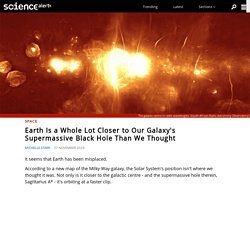

Earth Is a Whole Lot Closer to Our Galaxy's Supermassive Black Hole Than We Thought. It seems that Earth has been misplaced.

According to a new map of the Milky Way galaxy, the Solar System's position isn't where we thought it was. Not only is it closer to the galactic centre - and the supermassive hole therein, Sagittarius A* - it's orbiting at a faster clip. It's nothing to be concerned about; we're not actually moving closer to Sgr A*, and we're in no danger of being slurped up. Rather, our map of the Milky Way has been adjusted, more accurately identifying where we have been all along.
And the survey beautifully demonstrates how tricky it is to map a galaxy in three dimensions from inside it. It's a problem that has long devilled our understanding of space phenomena. And distances are important - they help us determine the intrinsic brightness of objects. Another is the object CK Vulpeculae, a star that exploded 350 years ago. VERA, which started observing in 2000, is designed to help us calculate the distances to radio-emitting stars by calculating their parallax.
Pyramid-Size Asteroid Hurtles Past Earth (Again) Another day, another pyramid-size space rock barreling past Earth.

This time, the fast-moving visitor's name is 2019 SX5, and it's expected to pay our cosmic neighborhood a visit tonight (Oct. 10). SX5 is estimated to measure as much as 459 feet (140 meters) in diameter, about the height of the Great Pyramid of Giza. It's traveling at a blistering 49,000 mph (78,900 km/h) and will reach its closest point to our planet at around 11:07 p.m. GMT (7:07 p.m. ET), according to NASA's Center for Near Earth Object Studies (CNEOS). However, "close" by space standards is by no means near enough that the rock will pose a threat to Earth. Related: Photos: Russian Meteor Explosion Another pyramid-size asteroid cruised past Earth in July. But the risk of impacts with Earth from large near-Earth objects, or NEOs, is very low. By identifying and tracking large NEOs over time, space agencies can determine whether these rocks might be on a collision course with our planet.
Is this Fundamental Phenomenon of the Universe an Illusion? - The Daily Galaxy. Could both gravity and the Big Bang be an illusion?

In January 2010, Erik Verlinde, professor of Theoretical Physics and world-renowned string theorist, caused a worldwide stir with the publication of On the Origin of Gravity and the Laws of Newton, in which he challenged commonly held perceptions on gravity, going so far as to state ‘for me gravity doesn’t exist’. If he is proved correct, the consequences for our understanding of the universe and its origins in a Big Bang will be far-reaching. Verlinde, who received the Spinoza prize (the Dutch Nobel Prize) from the Netherlands Organisation for Science, is famous for developing this new theory, or idea, on gravity in which he says that gravity is an illusion.
"Gravity is not an illusion in the sense that we know that things fall," says Verline. " Most people, certainly in physics, think we can describe gravity perfectly adequately using Einstein’s General Relativity. "We have other phenomena in Physics like this," Verlinde continued. Watch: How much energy does it take to blow up a planet?
The prospect of blowing entire planets to smithereens isn't exactly pertinent for us Earthlings, but Star Wars fans will know that in three of the seven films, a device capable of such destruction makes life very difficult for the protagonists.

Until we find ourselves locked in a similarly bloody battle with some kind of intergalactic enemy, we really don't need to know precisely how much power it would take to blow up an entire planet... but that doesn't make the mathematical problem-solving behind the scenario any less awesome. In the video above, Scott Manley says it's actually not as hard you might think to figure out the answer, because there are already scientific papers out there that have done all the work for you. "Imagine if you grab a rock from the surface of a planet, and shoot it off at escape velocity," says Manley. Watch the video above by Scott Manley to see how he figures out the answer. NASA has captured something HUGE escaping a supermassive black hole. Ivan Ivan has been part of the team at Universe Explorers since February 2015.He is a freelance writer, editor-in-chief of ancient-code.com He also writes for Svemir Online and Ancient Origins.History, Archaeology, Space and world’s mysteries are some of the topics he writes about.You can follow Ivan on Facebook" Latest posts by Ivan (see all) Two NASA telescopes managed to capture the moment a supermassive Black Hole’s corona launched out of the cosmic devourer.

The corona associated with Mrk 335 ejected from the black hole travelling at about 20 per cent the speed of light. Just when you thought things at NASA couldn’t get more exciting bam… they capture a mysterious ‘huge’ mass of energy somehow escaping a ‘supermassive black hole’. According to writing at NASA’s website: